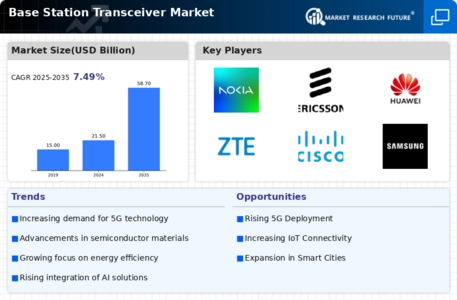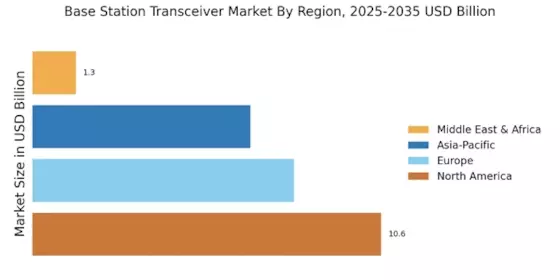Expansion of 5G Networks
The ongoing rollout of 5G networks is significantly influencing the Base Station Transceiver Market. As countries invest heavily in 5G infrastructure, the demand for advanced base station transceivers capable of supporting this next-generation technology is surging. The 5G technology promises enhanced speed, lower latency, and the ability to connect a vast number of devices simultaneously. According to industry estimates, the number of 5G connections is anticipated to exceed 1.7 billion by 2025. This rapid expansion necessitates the deployment of new base station transceivers that can efficiently manage the increased data load and provide seamless connectivity. Thus, the Base Station Transceiver Market is poised for substantial growth as operators seek to capitalize on the opportunities presented by 5G.
Emergence of IoT Applications
The proliferation of Internet of Things (IoT) applications is reshaping the Base Station Transceiver Market. As more devices become interconnected, the demand for reliable and efficient communication networks intensifies. IoT applications require low-latency and high-capacity networks, which in turn drives the need for advanced base station transceivers. The number of connected IoT devices is expected to surpass 30 billion by 2025, creating a substantial market for transceivers that can support these connections. This trend indicates a shift in focus for manufacturers, who must innovate to meet the specific requirements of IoT applications. Consequently, the Base Station Transceiver Market is likely to see a surge in demand for specialized transceiver solutions that cater to the unique needs of IoT.
Rising Demand for Mobile Data Services
The increasing reliance on mobile data services is a primary driver for the Base Station Transceiver Market. As consumers and businesses alike demand higher data speeds and more reliable connectivity, mobile network operators are compelled to upgrade their infrastructure. This trend is evidenced by the projected growth in mobile data traffic, which is expected to reach 77 exabytes per month by 2025. Consequently, the need for advanced base station transceivers that can handle this surge in data traffic becomes paramount. The Base Station Transceiver Market is thus witnessing a shift towards more sophisticated technologies that can support higher frequencies and improved bandwidth, ensuring that service providers can meet the evolving expectations of their users.
Regulatory Support for Telecommunications Development
Regulatory frameworks that support telecommunications development are a vital driver for the Base Station Transceiver Market. Governments worldwide are implementing policies aimed at enhancing connectivity and promoting competition among service providers. Such regulations often facilitate the deployment of new technologies and infrastructure, thereby stimulating market growth. For instance, initiatives to allocate spectrum for 5G and other advanced technologies are crucial for the expansion of base station transceivers. As regulatory bodies continue to prioritize telecommunications development, the Base Station Transceiver Market is likely to experience increased activity, with operators seeking to comply with new standards and leverage opportunities for growth.
Increased Investment in Telecommunications Infrastructure
Investment in telecommunications infrastructure is a critical driver for the Base Station Transceiver Market. Governments and private entities are recognizing the importance of robust communication networks, leading to increased funding for infrastructure projects. This trend is particularly evident in developing regions, where the need for reliable connectivity is paramount for economic growth. Reports indicate that global telecom infrastructure spending is projected to reach approximately 1.5 trillion by 2025. Such investments are likely to spur demand for base station transceivers, as operators upgrade their systems to accommodate new technologies and improve service quality. The Base Station Transceiver Market stands to benefit significantly from this influx of capital, as it enables the deployment of more advanced and efficient transceiver solutions.


















Leave a Comment